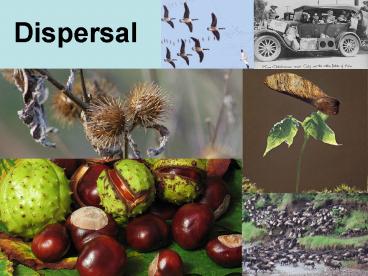Dispersal - PowerPoint PPT Presentation
1 / 26
Title: Dispersal
1
Dispersal
2
- Propagule
- Any plant material used for the purpose of plant
propagation - Asexual reproduction a propagule twig or leaf
section - Sexual reproduction a seed
- Dispersal
- Movement of an organism away from its point of
origin - I. Intra-range dispersal (ecological dispersal)
- Decreases competition with parents
- Example shade intolerant pine trees must
distribute seeds - to new disturbed sites
- II. Extra-range dispersal (biogeographical
dispersal) - Movement to a site outside the current
geographical range - Colonization of new regions
3
- Passive dispersal
- Outside physical force required to move the
propagule - Wind, water, birds, mammals
- Most plants are obligate passive dispersers
- Some animals (planktonic invertebrate larvae and
barnacles)
Planktonic stage of crab larvae
4
Active dispersal Mainly restricted to animals
Exceptions Dwarf mistletoe and squirting
cucumber exhibit ballistic dispersal
5
- Modes of passive dispersal
- Anemochores
- Dispersed by the wind
- Samara seeds of maple
- (Acer spp.) and certain pines (Pinus spp.)
Light (very little endosperm) More seeds, but
less resistant to dessication Random movement
(may land on inhospitable sites)
Acer saccharinum
Pinus sylvestris
6
The advantage of investing in larger seeds
7
- More anemochores Tufts of hair-like material
- Taraxacum officinale (dandelions) and Populus
spp. (cottonwood, poplar and aspen) - Rolling of tumbleweed (Salsola iberica)
- Web strands of black widow spiders (Lactrodectus
mactans)
8
- Hydrochores (thalassochores)
- Dispersed by moving water
- Adults, larvae and eggs of many aquatic organisms
- Crabs and starfish have planktonic juvenile stage
- The coconut palms (Cocos nucifera) husk and
shell protect the seed from salt water for long
time periods
9
- Anemohydrochores
- Dispersed by wind or water
- (eg. cottonwood)
- Zoochores
- Dispersed by animals
- Spikes that hook into
- fur or clothing
- (eg., ragweed
- Ambrosia spp.)
- Burclover
- (Medicago polymorpha)
- and garden vines
- (Plumbago spp.)
- Birds and squirrels
- store acorn seeds or
10
Anemochory and Zoochory Not much to
choose between them What are the advantages and
disadvantages of each?
11
(No Transcript)
12
- Endo-zoochory
- Seeds pass through animals digestive tract
- Generally larger seeds with more endosperm
- Fewer seeds and more costly to reproduce, but
more likely to end up at hospitable sites for
growth - Susceptible to reduced dispersal if transporting
species goes extinct
Bird feeding on a seed pod of Stenocereus
thurberi (organ pipe cactus)
13
Endozoochorous fungi Pilobolus spp.
Pilobolus spp. spores
14
- Anthropochores
- Dispersed by humans
- Ribwort (Plantago lanceolata) Sticky seeds
carried by clothing or fur
Many plants possess burrs, for transport by
either human clothing or animal fur
Goose grass
15
Colonization - Krakatau
16
Eastern Hemlock (Tsuga canadensis)
17
(No Transcript)
18
Stepping stone migration
19
Migration and Irruption Episodic explosions in
population size
dN / dt rN
20
Logistic population growth curves
dN / dt rN (K-N) / N)
21
(No Transcript)
22
Long distance migration Cattle egret
23
Invasive species
American muskrat
24
(No Transcript)
25
Purple loosestrife
26
The Impact of Climate Change On Dispersal and
Ecozone Distribution































